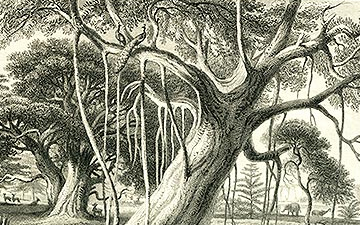Adansonia digitata (Baobab, Afrikaans: Kremetart, Hausa: Kuka, Sotho: Seboi, Tswana:Mowana, Tsonga: Shimuwu, Venda: Muvhuyu)[1] is the most widespread of the Adansoniaspecies on the African continent, found in the hot, dry savannahs of sub-Saharan Africa. It also grows, having spread secondary to cultivation, in populated areas. English common names for the Baobab include dead-rat tree (from the appearance of the fruits), monkey-bread tree (the soft, dry fruit is edible), upside-down tree (the sparse branches resemble roots) and cream of tartar tree.
The northern limit of its distribution in Africa is associated with rainfall patterns; only on theAtlantic coast and in the Sudan does its occurrence venture naturally into the Sahel. On the Atlantic coast, this may be due to spreading after cultivation. Its occurrence is very limited inCentral Africa, and it is found only in the very north of Southern Africa. In Eastern Africa, the trees grow also in shrublands and on the coast. In Angola and Namibia, the baobabs grow in woodlands, and in coastal regions, in addition to savannahs. It is also found in Dhofar region ofOman and Yemen in the Arabian Peninsula, Asia. This tree is also found in India, particularly in the dry regions of the country.[2][dead link]
The trees usually grow as solitary individuals, and are large and distinctive trees on the savannah, in thescrub, and near settled areas, with some large individuals living to well over a thousand years of age.[3] The tree bears very large, heavy, white flowers. The showy flowers are pendulous with a very large number of stamens. They carry a carrion scent and researchers have shown that they appear to be primarily pollinated by fruit bats of the subfamilyPteropodinae. The fruits are filled with pulp that dries, hardens, and falls to pieces which look like chunks of powdery, dry bread.[4]
The specific epithet digitata refers to the fingers of a hand, which the five leaflets (typically) in each cluster bring to mind.
The baobab is a traditional food plant in Africa, but is little-known elsewhere. The vegetable has been suggested to have the potential to improve nutrition, boost food security, foster rural development, and support sustainable land care.[5]
The African baobab’s fruit is 6 to 8 inches or 15 to 20 centimetres long. It contains 50% more calciumthan spinach, is high in antioxidants, and has three times the vitamin C of an orange.[6] It is sometimes called a superfruit.[6] The leaves can be eaten as relish. The dry pulp is either eaten fresh or dissolved in milk or water to make a refreshing drink. Young fresh leaves are cooked in a sauce, and sometimes are dried and powdered. The powder is called lalo in Mali and sold in many village markets in Western Africa. Oil extracted by pounding the seeds can be used for cooking but this is not widespread.[7]
In 2008, the European Union approved the use and consumption of baobab fruit as an ingredient insmoothies and cereal bars.[8]
The United States Food and Drug Administration granted generally recognized as safe status to baobab dried fruit pulp as a food ingredient in 2009.[9]
Baobab leaves are sometimes used as forage for ruminants in dry season. The oilmeal, which is a byproduct of oil extraction, can also be used as animal feed.[10] To grow A. digitata from a seed, cutting into the thick seed coat greatly speeds up germination, from months or years to seven days.
(From Wikipedia, September 2013)



